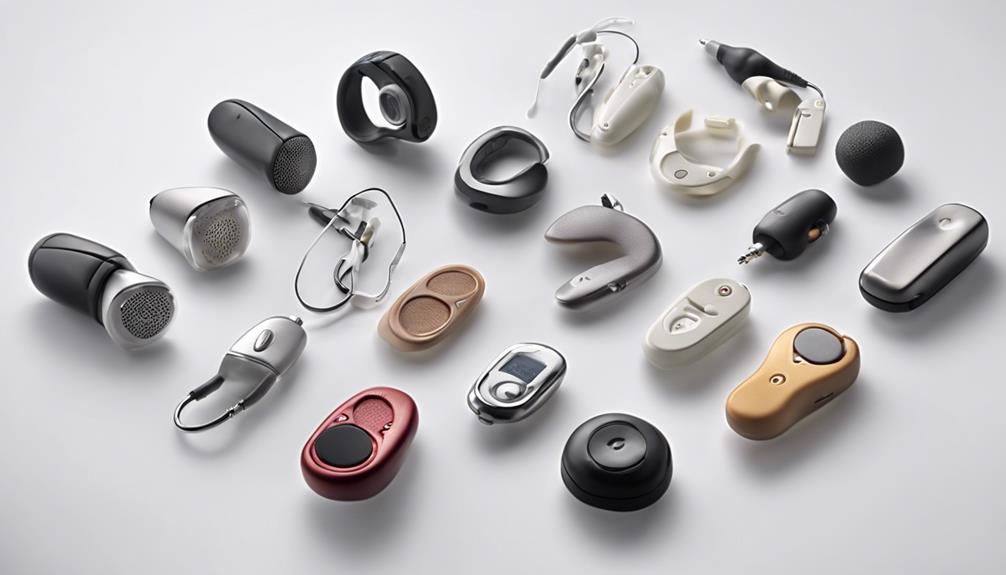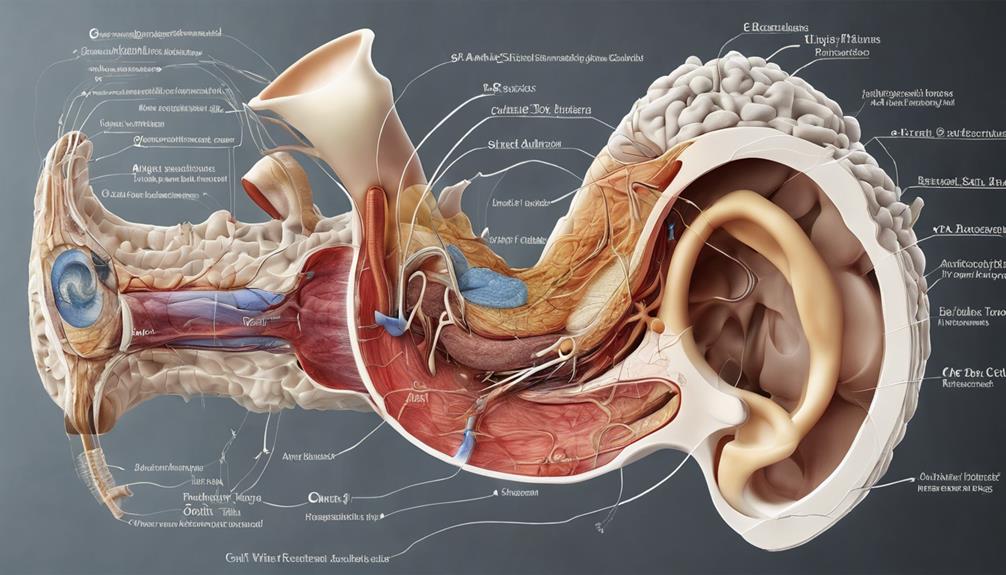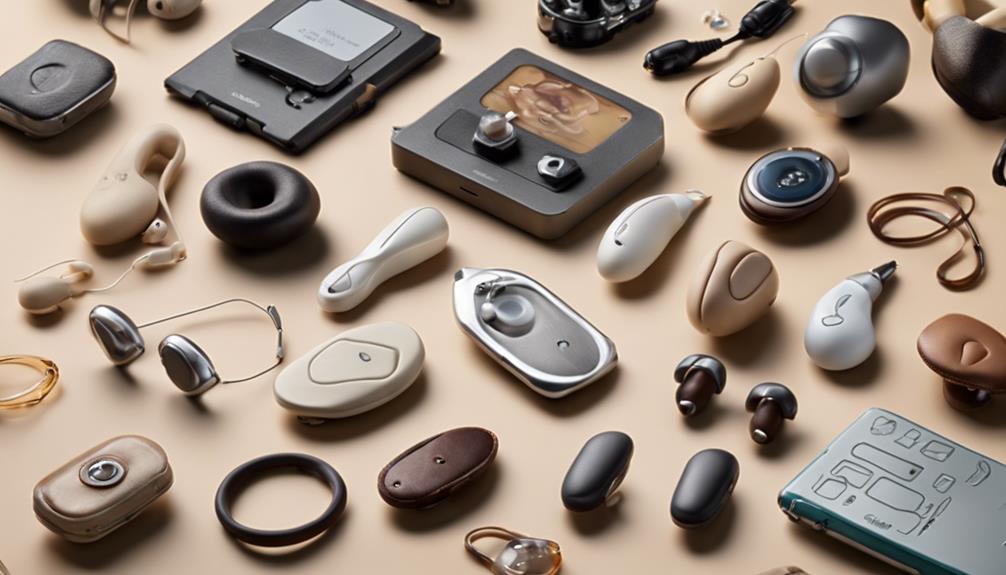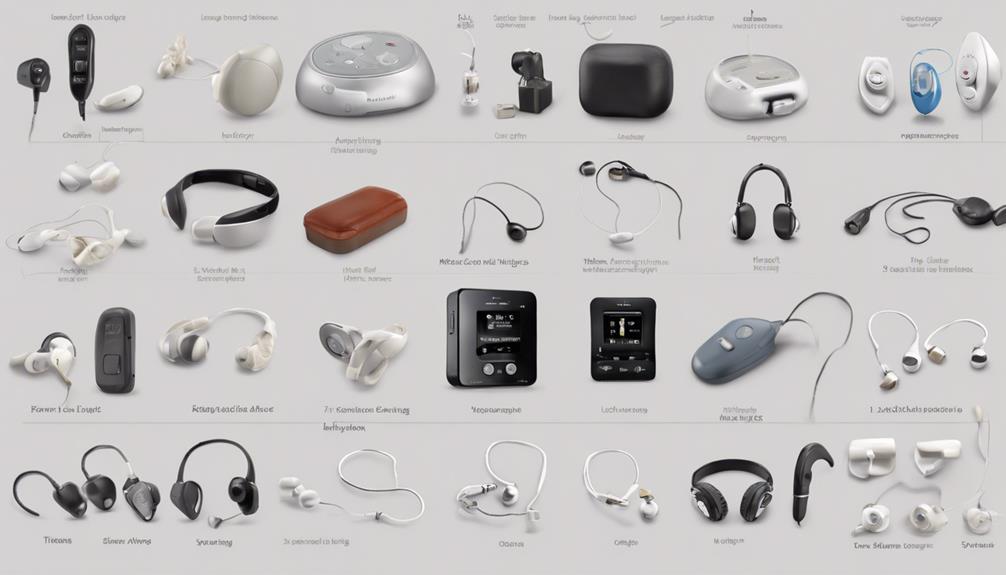As we explore the realm of hearing aid technology, we discover ourselves at the crossroads of cutting-edge innovation and improved accessibility.
With seven distinct types to consider, each catering to different needs and preferences, the landscape of hearing assistance devices unveils a plethora of possibilities for enhancing auditory experiences.
From Audio Induction systems to Bluetooth devices, the array of options beckons us to uncover the nuances and capabilities hidden within each device, potentially revolutionizing the way we perceive sound in our daily lives.
Key Takeaways
- Hearing aids and personal amplifiers improve speech clarity and understanding.
- Wireless listening systems like FM and Bluetooth devices enhance sound clarity in various settings.
- TV listening solutions, including wireless headphones and infrared systems, enhance TV viewing independently.
- Telephone amplifiers reduce background noise and enhance communication experience.
Hearing Aids
When considering hearing support options, hearing aids emerge as essential electronic devices for individuals facing hearing loss. These assistive listening devices come in various types, such as behind-the-ear (BTE), in-the-ear (ITE), and completely-in-the-canal (CIC) styles. The background of hearing aids has seen significant advancements, with digital options offering features like noise reduction, feedback cancellation, and programmable settings to cater to diverse needs. By amplifying sound, hearing aids play a crucial role in improving speech clarity and understanding, ultimately enhancing communication and quality of life for those with hearing impairments.
Regular maintenance, adjustments, and professional fittings are vital for the optimal performance of hearing aids. Individuals utilizing these devices should seek regular check-ups with audiologists to ensure proper functioning and comfort. Understanding the different types of hearing aids available and their features is essential for selecting the most suitable option based on individual requirements. By staying informed about the advancements in hearing aid technology, users can make informed decisions to improve their auditory experience effectively.
Personal Amplifiers

As we explore further options for hearing support beyond traditional hearing aids, personal amplifiers offer a portable solution designed to enhance one-on-one conversations or TV listening. These devices are compact and use a microphone to capture sound, amplifying it to improve reception. Personal amplifiers are particularly useful in environments with background noise, such as family gatherings, as they filter out unwanted sounds, leading to enhanced speech clarity. Their versatility allows for seamless transition between indoor and outdoor use, catering to various listening needs. Below is a table illustrating key features of personal amplifiers:
| Feature | Description | Benefits |
|---|---|---|
| Portable Design | Lightweight and easy to carry around for on-the-go use | Convenient mobility |
| Microphone | Captures sound for amplification | Improved sound reception |
| Background Noise Filtering | Minimizes unwanted noise for clearer audio | Enhanced speech clarity |
| Indoor and Outdoor Use | Suitable for various settings, from quiet indoor spaces to bustling outdoor areas | Versatile listening options |
| Speech Clarity | Amplifies speech frequencies to enhance understanding | Improved communication quality |
FM Systems
FM Systems, also known as frequency modulation systems, are advanced assistive listening devices that wirelessly transmit sound via radio waves, providing enhanced clarity and accessibility in various settings. These systems are versatile and can be used with or without hearing aids to enhance sound clarity. Here are some key points about FM systems:
- Suitability for Various Settings: FM systems are commonly used in group meetings, classrooms, and churches, both indoors and outdoors, ensuring clear sound reception.
- Portable Solutions: Offering portable solutions, FM systems provide individuals with amplified sound in different environments, making them convenient for daily use.
- Background Noise Reduction and Speech Understanding: FM systems are effective in reducing background noise, enhancing speech understanding, and improving communication for users with hearing loss.
Infrared Systems

Utilizing advanced infrared technology, these systems wirelessly transmit sound via invisible light beams, catering to specific indoor settings such as theaters and churches.
Infrared systems are ideal for use in large group settings, ensuring privacy by limiting the signal range to the intended area. The technology's effectiveness relies on maintaining a direct line of sight between the transmitter and receiver for optimal performance.
For individuals with hearing loss, these systems offer enhanced sound quality in environments where clarity is crucial, such as during theatrical performances or religious services. Moreover, specialized infrared devices are available for home TV listening, providing a tailored listening experience.
Bluetooth Devices
Bluetooth devices for hearing support offer significant benefits due to their wireless connectivity capabilities. They provide seamless compatibility with various devices, including smartphones and TVs, enhancing user experience.
These devices prioritize convenience and personalized hearing support, making them a valuable tool for individuals with hearing impairments.
Wireless Connectivity Benefits
With wireless connectivity benefits in assistive listening devices, users can seamlessly link their hearing aids to various gadgets for enhanced sound quality and control. Bluetooth devices offer a range of advantages:
- Stream audio directly to hearing aids, providing improved sound quality.
- Utilize Bluetooth technology to enhance compatibility with smartphones, TVs, and other devices.
- Reduce interference and distortion, creating a more personalized listening experience.
These benefits empower users to effortlessly manage volume adjustments and settings through smartphone apps, contributing to a more convenient and tailored auditory experience. Bluetooth connectivity revolutionizes the way individuals interact with their environment, offering unparalleled accessibility and functionality in the realm of hearing support.
Compatibility With Devices
Enhancing the connectivity of assistive listening devices with a wide array of devices, including smartphones and TVs, revolutionizes the sound transmission experience for users with hearing impairment. Bluetooth devices offer seamless connectivity, allowing individuals to stream audio wirelessly from their smartphones or TVs to their assistive listening devices. This Bluetooth compatibility provides enhanced sound transmission, personalized listening experiences, convenience, and versatility. Users can adjust volume levels and settings directly from their connected Bluetooth devices, eliminating the need for additional accessories and wires. By integrating Bluetooth technology into assistive listening devices, users can enjoy a modern and streamlined solution for their hearing support needs.
| Bluetooth Devices | Benefits |
|---|---|
| Seamless Connectivity | Easy pairing with smartphones and TVs |
| Enhanced Sound Transmission | Improved audio quality and clarity |
| Personalized Listening Experiences | Customized settings for individual needs |
Telephone Amplifiers

Telephone amplifiers, commonly used by individuals with hearing loss, significantly increase the volume of phone calls while enhancing clarity and reducing background noise. These devices are beneficial for hearing aid users and provide a clearer sound experience during personal phone conversations. When considering telephone amplifiers, users can expect the following features:
- Elimination of Background Noise: Telephone amplifiers effectively reduce unwanted background noise, allowing users to focus on the conversation without distractions.
- Tone Control Settings: Some models offer customizable tone control settings, enabling users to adjust the sound based on their preferences for optimal listening comfort.
- Portability and Easy Installation: Telephone amplifiers are portable and easy to install, making them convenient for use with most landline telephones. Users can effortlessly set up the device at home or in the office, enhancing their communication experience.
TV Listening Systems

TV listening systems are designed to help individuals with hearing difficulties enjoy television more comfortably. They offer a variety of solutions, such as wireless headphones, infrared devices, and Bluetooth transmitters, which provide enhanced sound quality without distortion. These options cater to a broader audience by functioning independently of hearing aids, ultimately improving the overall TV viewing experience.
These devices have become popular for their ability to address the specific needs of those with hearing impairments, making it easier for them to follow along with their favorite programs. They are a convenient and effective way to enhance the audio output from the television, ensuring a more enjoyable and immersive viewing experience for all users.
Wireless Headphones for TV
Wireless headphones for TV, also referred to as TV listening systems, offer personalized sound directly to users without disturbing others in the vicinity. These systems utilize RF or Bluetooth technology to transmit audio wirelessly from the TV to the headphones. Users can independently adjust the volume, enhancing dialogue clarity and reducing background noise for a superior TV watching experience. Specifically designed for individuals with hearing loss, these headphones ensure that users don't miss out on any important sounds while enjoying TV shows, movies, or music.
Additionally, some TV listening systems feature tone control, balance adjustment, and comfortable wearing options for extended use comfort.
- Provide personalized sound without disturbing others.
- Use RF or Bluetooth technology for wireless transmission.
- Allow independent volume control for enhanced clarity and reduced background noise.
Infrared TV Listening Devices
Moving from the realm of wireless headphones for TV, the focus now shifts to Infrared TV Listening Devices (TV Listening Systems) that cater specifically to individuals with hearing impairment. These devices utilize invisible light beams to transmit sound wirelessly, offering clear sound reception ideal for indoor use in theaters, homes, and public venues.
Infrared systems ensure privacy and focused listening by restricting the signal within the same room, preventing interference. They're compatible with headphones or neck loops, providing personalized listening experiences. Additionally, these devices are known for their easy setup and operation, making them convenient for individuals seeking enhanced TV audio without the need for complex installations.
Bluetooth TV Transmitters
We can enhance the TV viewing experience for individuals with hearing impairments by utilizing Bluetooth TV transmitters. These devices wirelessly stream audio directly to compatible hearing aids or headphones, offering personalized listening experiences. Bluetooth TV transmitters allow users to control the volume conveniently and eliminate the need for long cables or separate receivers, ensuring an efficient setup for TV audio streaming.
With versatile compatibility with various TV models and hearing aid brands, Bluetooth TV transmitters provide seamless connectivity options. Additionally, the discreet nature of these transmitters allows individuals with hearing loss to enjoy TV without disturbing others nearby.
Frequently Asked Questions
What Are the Different Types of Hearing Assistive Devices?
We've researched the different types of hearing assistive devices. These devices serve to enhance sound clarity for individuals with hearing loss.
They include:
- Audio induction loops
- FM systems
- Infrared systems
- Personal amplified systems
- Bluetooth systems
Each type caters to specific needs and preferences, offering options for indoor and outdoor settings.
Audio induction loops use electromagnetic energy, FM systems transmit sound wirelessly, and infrared systems utilize light beams for transmission.
Personal amplified systems are great for one-on-one conversations, while Bluetooth systems are compatible with hearing aids.
What Are the Devices for Auditory Hearing?
We've explored various assistive listening devices for auditory hearing. These tools, ranging from audio induction loops to Bluetooth systems, serve to amplify sound and minimize background noise for improved clarity.
Each device caters to specific environments, like large spaces for audio induction loops and group settings for FM systems. Understanding these different types empowers individuals with hearing loss to select the most suitable device for their unique needs.
What Devices Are Used in Hearing Aid?
We use various devices in hearing aids to enhance sound quality and accessibility. Telecoils, commonly found in hearing aids, receive electromagnetic signals, reducing background noise and improving clarity.
These components are essential for connecting with assistive listening systems, like hearing loop systems, for better sound reception in noisy environments.
Our hearing aids and cochlear implants are equipped with telecoils, allowing us to switch to telecoil mode for improved auditory experiences.
What Is a Device That Helps in Hearing?
We've explored various devices that can assist with hearing loss, and one standout option is the personal amplifiers. These handy gadgets are designed to amplify sounds in the user's immediate surroundings, making it easier to hear conversations or important sounds.
Personal amplifiers are portable, discreet, and can be particularly helpful in situations where background noise might interfere with hearing. They provide a direct boost in sound volume, aiding individuals in various listening environments.
Conclusion
As we navigate the world with assistive listening devices, we aren't just hearing better – we're truly tuning into the symphony of life.
Each device serves as a key to unlock new experiences, connecting us to the vibrant soundscape around us.
Embracing these tools symbolizes a harmonious blend of technology and humanity, empowering us to fully engage in conversations, music, and the world at large.
Let's continue to listen, learn, and thrive together.











